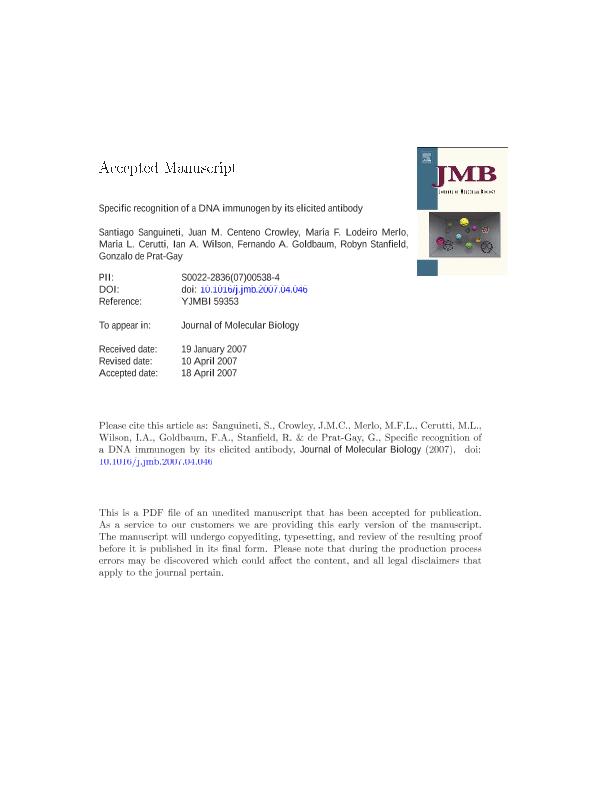Mostrar el registro sencillo del ítem
dc.contributor.author
Sanguineti, Santiago

dc.contributor.author
Centeno Crowley, Juan M.
dc.contributor.author
Lodeiro, Anibal

dc.contributor.author
Cerutti, Maria Laura

dc.contributor.author
Goldbaum, Fernando Alberto

dc.contributor.author
Wilson, Ian A.
dc.contributor.author
Stanfield, Robyn L.
dc.contributor.author
de Prat Gay, Gonzalo

dc.date.available
2018-03-02T20:26:33Z
dc.date.issued
2007-06
dc.identifier.citation
Sanguineti, Santiago; Centeno Crowley, Juan M.; Lodeiro, Anibal; Cerutti, Maria Laura; Goldbaum, Fernando Alberto; et al.; Specific Recognition of a DNA Immunogen by its Elicited Antibody; Academic Press Ltd - Elsevier Science Ltd; Journal Of Molecular Biology; 370; 1; 6-2007; 183-195
dc.identifier.issn
0022-2836
dc.identifier.uri
http://hdl.handle.net/11336/37739
dc.description.abstract
DNA recognition by antibodies is a key feature of autoimmune diseases, yet model systems with structural information are very limited. The monoclonal antibody ED-10 recognizes one of the strands of the DNA duplex used in the immunogenic complex. Modifications of the 5′ end decrease the binding affinity and short oligonucleotides retain high binding affinity. We determined crystal structures for the Fab bound to a 6-mer oligonucleotide containing the specific sequence that raised the antibody and compared it with the unliganded Fab. Only the first two bases from the 5′ end (dTdC) display electron density and we observe four key hydrogen bonds at the interface. The thymine ring is stacked between TrpH50 and TrpH95, and the cytosine ring is packed against TyrL32. Upon DNA binding, TyrH97 and TrpH95 rearrange to allow subnanomolar binding affinity, five orders of magnitude higher than other reported complexes, possibly because of having gone through affinity maturation. This structure represents the first bona fide antibody DNA immunogen complex described in atomic detail.
dc.format
application/pdf
dc.language.iso
eng
dc.publisher
Academic Press Ltd - Elsevier Science Ltd

dc.rights
info:eu-repo/semantics/openAccess
dc.rights.uri
https://creativecommons.org/licenses/by-nc-nd/2.5/ar/
dc.subject
Anti-Dna
dc.subject
Antibody
dc.subject
Autoimmune
dc.subject
Dna Binding
dc.subject
Structure
dc.subject.classification
Otras Ciencias Químicas

dc.subject.classification
Ciencias Químicas

dc.subject.classification
CIENCIAS NATURALES Y EXACTAS

dc.title
Specific Recognition of a DNA Immunogen by its Elicited Antibody
dc.type
info:eu-repo/semantics/article
dc.type
info:ar-repo/semantics/artículo
dc.type
info:eu-repo/semantics/publishedVersion
dc.date.updated
2017-12-12T20:02:16Z
dc.journal.volume
370
dc.journal.number
1
dc.journal.pagination
183-195
dc.journal.pais
Estados Unidos

dc.description.fil
Fil: Sanguineti, Santiago. Fundación Instituto Leloir; Argentina. Consejo Nacional de Investigaciones Científicas y Técnicas; Argentina
dc.description.fil
Fil: Centeno Crowley, Juan M.. Fundación Instituto Leloir; Argentina
dc.description.fil
Fil: Lodeiro, Anibal. Fundación Instituto Leloir; Argentina. Consejo Nacional de Investigaciones Científicas y Técnicas; Argentina
dc.description.fil
Fil: Cerutti, Maria Laura. Fundación Instituto Leloir; Argentina. Consejo Nacional de Investigaciones Científicas y Técnicas; Argentina
dc.description.fil
Fil: Goldbaum, Fernando Alberto. Fundación Instituto Leloir; Argentina. Consejo Nacional de Investigaciones Científicas y Técnicas; Argentina
dc.description.fil
Fil: Wilson, Ian A.. The Scripps Research Institute; Estados Unidos
dc.description.fil
Fil: Stanfield, Robyn L.. The Scripps Research Institute; Estados Unidos
dc.description.fil
Fil: de Prat Gay, Gonzalo. Fundación Instituto Leloir; Argentina. Consejo Nacional de Investigaciones Científicas y Técnicas; Argentina
dc.journal.title
Journal Of Molecular Biology

dc.relation.alternativeid
info:eu-repo/semantics/altIdentifier/doi/http://dx.doi.org/10.1016/j.jmb.2007.04.046
dc.relation.alternativeid
info:eu-repo/semantics/altIdentifier/url/https://www.sciencedirect.com/science/article/pii/S0022283607005384
Archivos asociados
